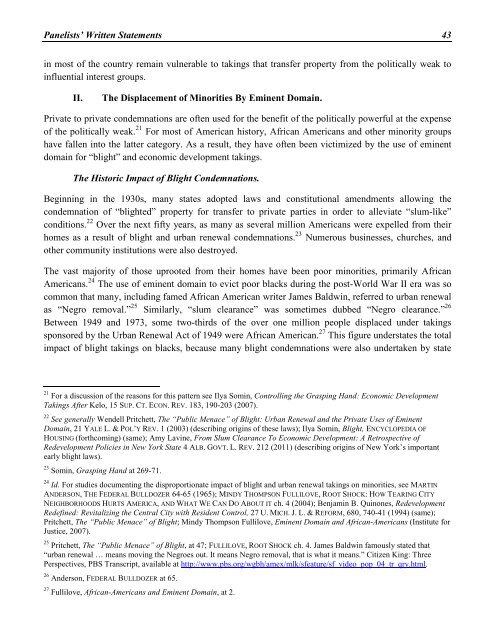Create successful ePaper yourself
Turn your PDF publications into a flip-book with our unique Google optimized e-Paper software.
Panelists’ Written Statements 43in most of the country remain vulnerable to takings that transfer property from the politically weak toinfluential interest groups.II.The Displacement of Minorities By <strong>Eminent</strong> <strong>Domain</strong>.Private to private condemnations are often used for the benefit of the politically powerful at the expenseof the politically weak. 21 For most of American history, African Americans and other minority groupshave fallen into the latter category. As a result, they have often been victimized by the use of eminentdomain for “blight” and economic development takings.The Historic Impact of Blight Condemnations.Beginning in the 1930s, many states adopted laws and constitutional amendments allowing thecondemnation of “blighted” property for transfer to private parties in order to alleviate “slum-like”conditions. 22 Over the next fifty years, as many as several million Americans were expelled from theirhomes as a result of blight and urban renewal condemnations. 23 Numerous businesses, churches, andother community institutions were also destroyed.The vast majority of those uprooted from their homes have been poor minorities, primarily AfricanAmericans. 24 The use of eminent domain to evict poor blacks during the post-World War II era was socommon that many, including famed African American writer James Baldwin, referred to urban renewalas “Negro removal.” 25 Similarly, “slum clearance” was sometimes dubbed “Negro clearance.” 26Between 1949 and 1973, some two-thirds of the over one million people displaced under takingssponsored by the Urban Renewal Act of 1949 were African American. 27 This figure understates the totalimpact of blight takings on blacks, because many blight condemnations were also undertaken by state21 For a discussion of the reasons for this pattern see Ilya Somin, Controlling the Grasping Hand: Economic DevelopmentTakings After Kelo, 15 SUP. CT. ECON. REV. 183, 190-203 (2007).22 See generally Wendell Pritchett, The “Public Menace” of Blight: Urban Renewal and the Private Uses of <strong>Eminent</strong><strong>Domain</strong>, 21 YALE L. & POL’Y REV. 1 (2003) (describing origins of these laws); Ilya Somin, Blight, ENCYCLOPEDIA OFHOUSING (forthcoming) (same); Amy Lavine, From Slum Clearance To Economic Development: A Retrospective ofRedevelopment Policies in New York State 4 ALB. GOVT. L. REV. 212 (2011) (describing origins of New York’s importantearly blight laws).23 Somin, Grasping Hand at 269-71.24 Id. For studies documenting the disproportionate impact of blight and urban renewal takings on minorities, see MARTINANDERSON, THE FEDERAL BULLDOZER 64-65 (1965); MINDY THOMPSON FULLILOVE, ROOT SHOCK: HOW TEARING CITYNEIGHBORHOODS HURTS AMERICA, AND WHAT WE CAN DO ABOUT IT ch. 4 (2004); Benjamin B. Quinones, RedevelopmentRedefined: Revitalizing the Central City with Resident Control, 27 U. MICH. J. L. & REFORM, 680, 740-41 (1994) (same);Pritchett, The “Public Menace” of Blight; Mindy Thompson Fullilove, <strong>Eminent</strong> <strong>Domain</strong> and African-Americans (Institute forJustice, 2007).25 Pritchett, The “Public Menace” of Blight, at 47; FULLILOVE, ROOT SHOCK ch. 4. James Baldwin famously stated that“urban renewal … means moving the Negroes out. It means Negro removal, that is what it means.” Citizen King: ThreePerspectives, PBS Transcript, available at http://www.pbs.org/wgbh/amex/mlk/sfeature/sf_video_pop_04_tr_qry.html.26 Anderson, FEDERAL BULLDOZER at 65.27 Fullilove, African-Americans and <strong>Eminent</strong> <strong>Domain</strong>, at 2.


